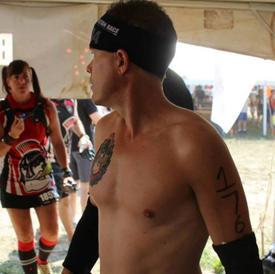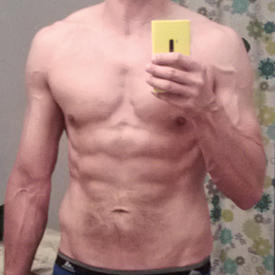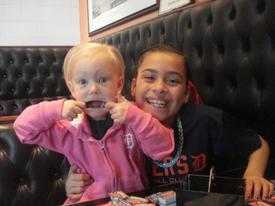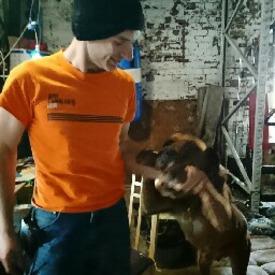Lose belly/back fat and bulk up upper body thoughts?

rickloving
Posts: 90 Member
I'm 43, 5'9" 155lbs, thin framed, but carry a couple of lbs of excess fat around my waist (belly and love handles). I'm a runner and cyclist (but enjoy eating due). I am currenlty eating about a 1600 calorie diet and started a weight training program to attempt to get some defination in my upper body and drop the few lbs of fat. I have been told by a few individuals that trying to lose the few fat lbs through calorie reduction at the same time as trying to build muscle mass is counter productive..
Would it make more sense to go back up to my AMR calorie level and focus on the weights or to drop the body fat and then switch to the increased mass plan?
Honestly, I would rather drop the belly fat and just be skinny with my shirt off , especially as it helps my running and cycling more than the upper body developement...
Thoughts or suggestion?
Would it make more sense to go back up to my AMR calorie level and focus on the weights or to drop the body fat and then switch to the increased mass plan?
Honestly, I would rather drop the belly fat and just be skinny with my shirt off , especially as it helps my running and cycling more than the upper body developement...
Thoughts or suggestion?
0
Replies
-
Either path will make you look better.
You will likely be happy with either choice if you stick to it long enough to see results.0 -
Continue lifting. Continue eating at a deficit. If you're new, you may notice some muscle gain at first that will taper off. But, by lifting, you'll retain muscle mass while dropping fat, so more of your loss will be from fat and not LBM.0
-
The calorie deficit will lose fat.
The weights will help you not to lose muscle as well and as a relative 'newb' may also help you gain a little muscle.
If you leave off the weights, you may find yourself losing muscle as well as fat, leaving you 'skinny fat', where you've got less fat, but still look podgy as there's less muscle.
Sounds like you're on the right track to me.0 -
Dead Lifts and Squats For Life0
-
Abs are made in the kitchen.... With that said you can stil lift to build your upper body and still lose the belly fat. No amount of training will get you to lose that without proper diet. I say keep what you are doing training wise and maybe re-evaluate your eating. My last bit of belly fat was hard to get rid of until I really nailed down my eating for about 3-4 weeks. I cut out a lot of beef and focused on leaner meats (chicken and fish) and adjusted my portion control.0
-
OP, I think I can help you out from personal experience: I am 40, 5'9" and currently 151 lbs. Over the last 3-4 months, I've managed to define my upper body significantly while losing ~15-20 lbs of fat, mostly from my belly and back. As others have mentioned, this has mainly been through a healthy diet + portion control. Based on caliper measurements, I estimate I've gained roughly 1 lb of lean body mass. (135 lbs to 136 lbs) My goals are a little bit different--I'm not interested in distance running or cycling, as my current hobby is Taekwondo. Outside of class, I do interval training (aka wind sprints) for cardio. To maintain my lean muscle mass, I primarily do body-weight strength training: incline push-ups, pull-ups, chin-ups, jump squats, and planks. http://www.nerdfitness.com/blog/2011/03/10/angry-birds-workout-plan/0
-
Oops. That should say "decline pushups". I always get those mixed up. Decline pushups are harder than regular pushups, because more of your body weight is on your arms. Incline pushups are easier than regular pushups, because more of your body weight is on your feet. Anyway, I started with regular, but I quickly realized I was doing too many reps for proper strength training. (Great for muscle endurance, though!) So I switched to decline pushups. I'm hoping to build up to "head stand pushups" one day!0
-
Keep lifting and keep eating at your deficit. You won't build muscle, but more of the weight lost will be fat. Deficit without lifting will burn fat, but also more muscle mass. Always better to preserve what muscle you have.0
This discussion has been closed.
Categories
- All Categories
- 1.4M Health, Wellness and Goals
- 396.9K Introduce Yourself
- 44.2K Getting Started
- 260.9K Health and Weight Loss
- 176.3K Food and Nutrition
- 47.6K Recipes
- 232.8K Fitness and Exercise
- 455 Sleep, Mindfulness and Overall Wellness
- 6.5K Goal: Maintaining Weight
- 8.7K Goal: Gaining Weight and Body Building
- 153.3K Motivation and Support
- 8.3K Challenges
- 1.3K Debate Club
- 96.5K Chit-Chat
- 2.6K Fun and Games
- 4.5K MyFitnessPal Information
- 16 News and Announcements
- 18 MyFitnessPal Academy
- 1.4K Feature Suggestions and Ideas
- 3.1K MyFitnessPal Tech Support Questions





